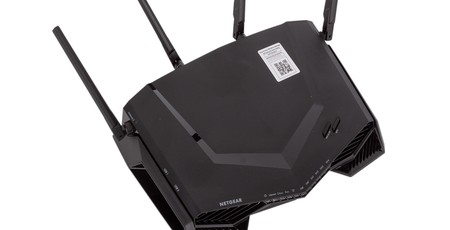
Netduma DumaOS

DumaOS is managed entirely in-browser rather than via a separate app. The Dashboard screen gives you an overview of your network status (including the optional guest network) in neatly separated windows which can be dragged around and resized. It’s certainly a much more graphical UI than I’m used to from routers. The ability to pin different elements to this dashboard opens up customisation options, and the help icons on each one are genuinely handy and thorough.

The System Information screen has extra detail regarding usage and status of various bits, as well as the onboard log file. The Settings tab, meanwhile, opens a somewhat more traditional router menu with advanced settings for those who need them. This is where you can do things like set up a guest network, apply content filters, access USB storage, and set up email notifications. It’s the remaining four screens where the network management and gaming credentials really shine, though.

Device Manager gives you a simple network map to visualise what’s connected to what on your network. It’s very easy to understand, and clicking a computer, phone, or other device allows you to ruthlessly block it. Maybe you want to, I don’t know, train your housemate Pavlovian style by blocking the Netflix device until the dishes are washed.

The Network Monitor, meanwhile, is just that, showing you what devices are using what bandwidth in real time, as well as giving you an overall picture of the network as a whole. With both of these screens, it’s again the clarity of presentation that makes them handy.

The Geo-Filter is a neat idea, touted as a means of genuinely improving your average in-game experience in spite of the numerous unknowns between you and the host server. Essentially, you set your home location on the global map by dropping a pin, then set a radial distance that represents a barrier to other players (or more likely servers); anyone attempting to connect to your game from outside the barrier will be blocked from doing so, minimising you chances of a laggy, game-disrupting experience. The distance is represented by a radar-style sweeping circle that’s honestly quite cool, and incoming connections will show up as approximate locations either within or outside it.
Admittedly, Geo-Filter is primarily a feature for console users where control over the server for a game is nearly always up to the game itself, but it still has its uses for PC users. In the Device menu, you select your console or PC from the list of devices on the network, then pick a game for which you want it to activate the Geo-Filter. Whenever traffic for that game is detected for that device, the router’s filter kicks in for that game’s traffic based on the current distance set. Numerous popular games are supported, and PC users benefit from being able to select whole engines e.g. Unreal will work for both PUBG and Fortnite. If you don’t know a good distance, the map has profiles for each supported game with suggested settings. Many PC games are Spectator Mode only, whereby you can monitor connections, blacklisting or whitelisting specific people if needs be, but you won’t be able to use the location-based filter. However, the Unreal Engine does have a Filtering Mode enabled, and this worked fine for me in Fortnite. I also have a colleague that’s tried it with an Xbox One and Call of Duty, with positive results reported both in terms of ease of use and actual in-game experience.

The QoS (Quality of Service) screen has a very handy tool for allocating bandwidth, allowing you to give over more to gaming PCs and consoles so that they get priority whenever your network is congested – how I wish I had this power back at university! Obviously if there is minimal demand on the network, any device can use the full bandwidth unless you make the limits permanent. As more devices are added to the network, those you’ve given a larger share to remain dominant, albeit by less. There is upload/download separation too. Along the top of the screen are anti-bufferbloat sliders (again upload and download), meaning you can limit greedy apps to a set percentage of your overall bandwidth, keeping the pipes clearer for low-latency traffic like voice comms and online games that might otherwise get caught up and stutter. A quick test with PingPlotter 5 showed that this worked pretty well; a repeated ping to the same website would spike if I started large downloads, but activating anti-bufferbloat would reign the ping in back to near enough pre-download levels.

One final feature I want to touch on is integrated VPN, which is buried in the Settings menu. Netgear currently supports Hidemyass, allowing you to log in to your account directly on the router. It would be good to see more third-party support here; it is apparently forthcoming, but specifics are thin on the ground. Routing multiplayer gaming traffic is unlikely to be optimal, of course, but Netgear does point out a use case for streamers who want to avoid falling victim to DDOS attacks. I don’t have experience streaming, so I can’t really comment on this either way.

MSI MPG Velox 100R Chassis Review
October 14 2021 | 15:04





Want to comment? Please log in.